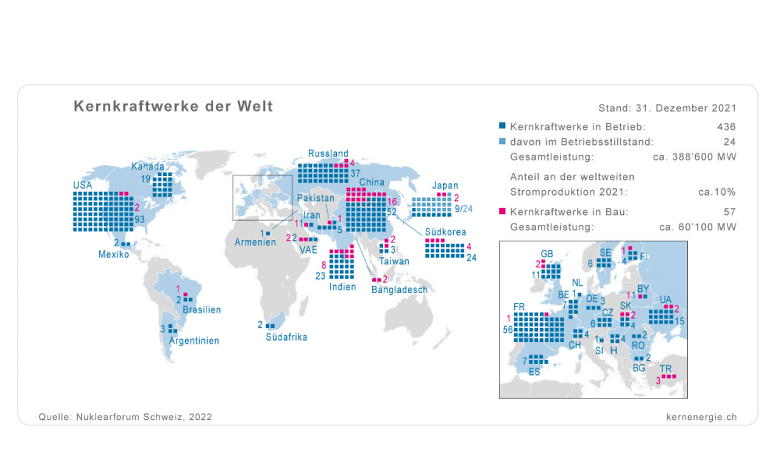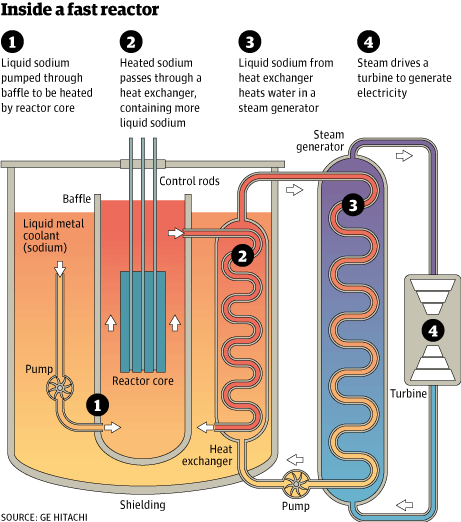Introduction
As part of our "Interdisciplinary project work 3" we will look at the past of the use of nuclear energy, the present of the use of nuclear energy and the future of the use of nuclear energy.
Summary
1) Historical dimension of nuclear energy in the last 100 years
1896
Antoine Henri Becquerel discovers radioactivity.
1898
In 1898, Marie and Pierre Curie discover the decay of the element radium into other elements, emitting ionising radiation.
1911
1911 Ernest Rutherford develops his theory of the structure of the atom and of radioactive decay, based on which Niels Bohr later develops an atomic model.
1939
1939 Joliot, Halban and Kowarski demonstrate the neutrons released during nuclear fission, which set a chain reaction in motion. Liese Meitner and Siegfried Flügge calculate the magnitude of the energy released during nuclear fission.
1942
In 1942, Enrico Fermi and his team design and build the first experimental nuclear reactor. They set the first controlled chain reaction in motion with Chicago Pile No. 1 (CP-1).
1951
In 1951, electricity is generated by nuclear energy for the first time on 20 December in the US state of Idaho with the experimental reactor EBR 1.
1956
October Completion of the UK's Calder Hall nuclear power station (NPP), the first nuclear power station used for commercial electricity generation.
1977
USA pulls out of fast breeder reactor technology under President Jimmy Carter for fear of proliferation of weapons-grade plutonium. The USA is also not dependent on this technology due to sufficient uranium deposits.
1979
On 28 March, an accident occurs at the US nuclear power plant Three Mile Island near Harrisburg. The core partially melts. The containment works.
1986
In 1986, on 26 April, the most serious accident in the history of the peaceful use of nuclear energy occurs in unit four of the Soviet nuclear power plant Chernobyl.
2000
On 15 December, the last unit of the Chernobyl nuclear power plant still in operation is decommissioned.
2005
2005 On 17 February, the Finnish government grants nuclear permission for the construction of the first third-generation reactor, Olkiluoto 3. On 28 June 2005, China, the European Union, India, Japan, Korea, Russia and the USA decide to build the ITER fusion reactor in Cadarache (France).
2011
On 11 March, a severe seaquake in Japan damages the Fukushima-Daiichi nuclear power plant.
2018
In China, two of the world's most advanced Western-designed nuclear power plants go into operation for the first time: the Framatome EPR in Taishan and the Westinghouse AP1000 in Sanmen.
2) Energy form today
-Internal energy
-Nuclear energy (e.g. nuclear power plant)
-Thermal or heat energy (e.g. volcano)
-Chemical energy (e.g. coal)
-Mechanical energy
-Kinetic (e.g. bicycle) or kinetic energy (e.g. car)
-Potential or positional energy ((skier descends from valley, fireman uses pole to slide down))
-Electrical energy (e.g. lightning)
-Radiant energy (e.g. sun)
2.1 Where is nuclear energy used?
The most important type of nuclear energy use is the generation of electrical energy in nuclear power plants. However, nuclear energy is also suitable for military use in nuclear weapons (atomic weapons).

3) The Energy form in the future (in 100 years)
Existing nuclear power plants in the world:

[1] Kernkraftwerke der Welt
3.1 How will nuclear energy be used in 100 years?
There isn’t just one option about the future of nuclear energy. There are plenty ideas about how nuclear energy will be used in 100 years. Here are some examples:
3.1.1 The use of nuclear waste
In 100 years, for example, the waste from nuclear energy could be used for energy production. The nuclear waste from the fuel rods is recycled in power reactors, i.e. used to generate energy. However, unlike in transmutation systems (accelerator-driven system), a self-sustaining chain reaction can occur in power reactors (reactor-driven system), which makes a reactor accident at least theoretically possible.
Many radioactively contaminated materials can - as far as economically justifiable - be cleaned (decontamination) and used normally if it can be proven that they are free of contamination or fall below the limits (free measurement). In addition, radioactive residues can be reused in nuclear technology; for example, low-level radioactive steel scrap is processed into shielding for waste containers.
One concept for the energetic utilisation of radioactive waste that has been under development since the 1950s is the travelling wave reactor. Like the breeder reactor, this incubates its fuel, but can also be operated with crude uranium or already spent nuclear fuel, among other things, and thus utilise the residues of its own production. Theoretically, it is therefore possible to use material as fuel that is currently considered radioactive waste. This would contribute to a roughly 20 to 50 times more efficient use of nuclear fuel. The technology required for this has been under development since the 1970s, but has so far only been used in a few commercial reactors.
The only breeder reactors operating commercially today are the Russian BN-600 and its successor BN-800, both at the Beloyarsk nuclear power plant in Sarechny, Russia. The BN-800 has been feeding electricity into the Russian grid since 10 December 2015 and has been in commercial operation since 31 October 2016.
Australia is currently (as of 2015) planning to build PRISM breeder reactors (General Electric and Hitachi) to recycle radioactive waste.
The dual-fluid reactor, if realised, could also use old fuel rods as fuel.

[2] Inside a fast reactor
3.1.3 Fifth, sixth, seventh generation nuclear reactor?
A total of 14 industrialised countries coordinate their research and development activities in the Generation IV International Forum (GIF). Despite the nuclear phase-out, Germany is indirectly involved in the GIF through the European Atomic Energy Community (Euratom).
The question arises as to whether nuclear energy is a suitable option for replacing CO 2intensive energy sources such as coal, and what additional capacity would be required for this would be necessary. The World Nuclear Association, a lobby group for nuclear energy, forecasts that 1,130 to 3,500 gigawatts of electrical capacity (GWel) could be provided by nuclear power plants by 2060, and as much as 11,000 GWel by 2100. If reactors with a capacity of 1,600 megawatts of electrical power (MWel) are taken as a basis, this would mean up to 6,800 new reactors or an increase by a factor of 15 compared to the current number of reactors.
PDF version:
IDAF3.
Text sources:
Kernd.de.
Mdr.de.
DerStandard.de.
Quarks.de.
Wikipedia.org.
Nuklearia.de.
Oeko.de.
Picture sources:
[1] Kernkraftwerke der Welt: Kkwderwelt.png.
[2] Inside a fast reactor: Nuclear-power.com.
Team Nuclear - Indiravadhanan Anandarajah and Tiziano Di Paola